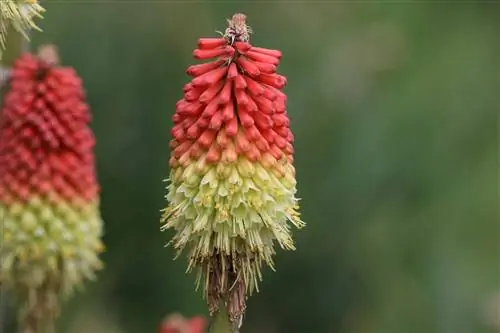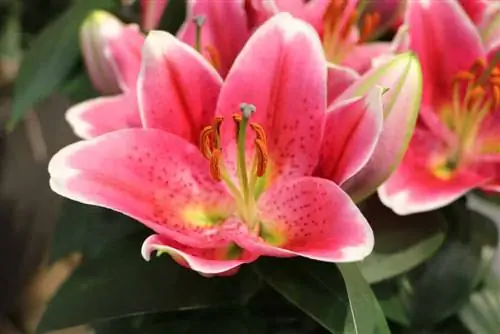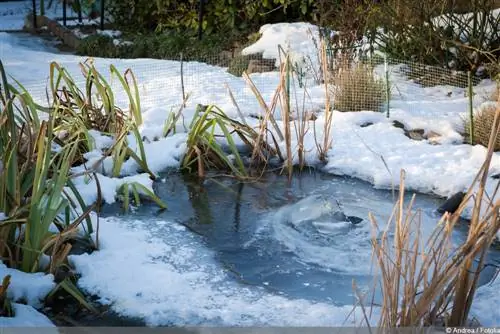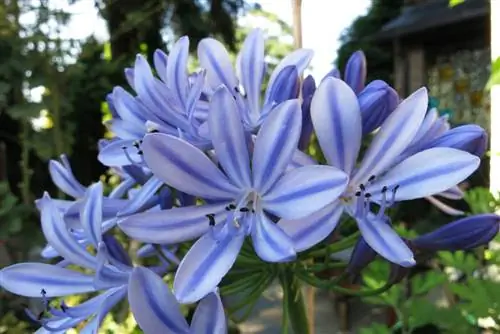- Author admin [email protected].
- Public 2023-12-17 03:39.
- Last modified 2025-01-24 12:45.
Torch lilies Kniphofia are herbaceous, perennial and in most cases evergreen plants. Depending on the variety, they can reach heights of between 80 and 160 cm. The exotic-looking inflorescences are raceme-shaped, with the flower stalks being relatively short. The small tubular flowers are intensely red at the top of the inflorescences and change color towards yellow towards the bottom. Some species are partially white or green. They wilt from bottom to top, so the flowering period is relatively long.
Plants
The best time to plant torch lilies is spring. Before planting, the soil should be thoroughly loosened and an appropriately sized planting hole dug. If there are several torch lilies, planting distances of around 50 cm are recommended. To improve the permeability of the soil, you can mix the excavated soil with compost. When planting, make sure to plant it so deep that the rosette is either level with the surface of the soil or is only slightly below it. After planting, press the soil well and water thoroughly.
Tip:
Autumn plantings are not advisable, as they will not grow well before the first frosts and can easily freeze.
Location requirements
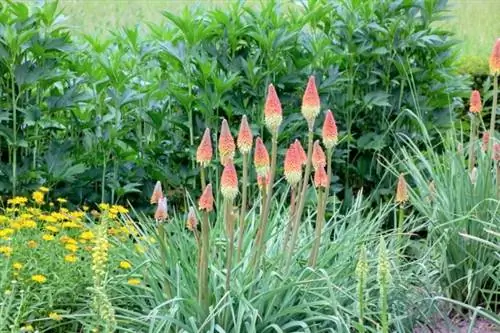
The Kniphofia thrives in fully sunny and wind-protected locations as well as in well-drained, not too nutrient-poor, fresh and humus-rich, sandy or calcareous, moderately moist and moderately dry soils. A high proportion of sand and lime is particularly good. Wind-protected location because the flower stalks, if they are already slightly bent, bend easily in the wind. It is best to equip floors that are too wet with a drainage layer to ensure good water drainage and avoid waterlogging. The soil should not dry out too much in summer and should not be too wet in winter. A high sand content can counteract this.
Caring for this magnificent plant
Caring for torch lilies is relatively straightforward. The water requirement is relatively high during the growth phase. Then you shouldn't save water. Short dry phases are tolerated; waterlogging must be avoided at all costs. In summer, it is better to water in the morning or evening, as drops of water on the leaves can cause burns in the blazing sun. The nutrient requirements are not very high. As a rule, it is sufficient to incorporate ripe compost in the spring and, if necessary, horn shavings into the soil in the fall. Particularly barren soils can also be improved with cow dung, for example in the form of pellets. Over-fertilization should be avoided as this would make the torch lily more susceptible to disease or pest infestation.
As far as pruning is concerned, only the flower stems are cut off just above the last pair of leaves after flowering, provided you do not want to harvest seeds for propagation. The leaves should definitely remain until spring, so they protect the sensitive heart of the plant. In spring they are then cut about a hand's width above the ground. Afterwards you should fertilize with compost.
Tip:
The small tubular flowers of the Kniphofia are often a playground for earwigs. To avoid this, fill a flower pot with straw or wood shavings.
Then cover the opening with rabbit wire or a net and place it upside down on the ground near the plant. The earwigs are then lured away from the plant and collect in the flower pot.
Overwintering torch lilies
- Most varieties react very sensitively to frost and winter wetness.
- It is best to cover the root area with dry leaves and pine branches.
- It is important that the respective cover is dry.
- Otherwise, rot can quickly occur.
- The leaves are tied together at the top and covered with pine branches.
- This is supposed to protect the heart of the plant from frost, winter wetness and the winter sun.
Tip:
To ensure that the plants survive the winter without damage, it is advisable to look for varieties with sufficient winter hardiness when purchasing.
Propagate
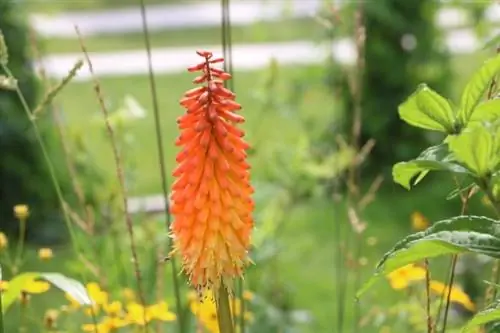
Sowing
Kniphofias can be sown in spring or early autumn. Seeds harvested from existing plants must be stratified, i.e. subjected to cold treatment. For example, you can store them in the refrigerator in winter. The seeds are placed flat in a permeable substrate and kept evenly moist. As soon as the first 4-5 leaves have formed, you can transplant on site.
Division
Root division is the simplest type of propagation, and this form of propagation is the only one from which pure plants can be obtained. In spring or early autumn, immediately after flowering, the fleshy rhizome is carefully dug up and divided into an appropriate number of pieces using a sharp knife. These are then planted again immediately. It is important that each individual section has sufficient root mass.
Tip:
Some specimens that are several years old also develop small daughter rosettes. After digging up the plants, you can carefully separate them and plant them.
Diseases and pests
Rot
Rot is a common problem caused by too much moisture. The reasons for this can be unfavorable site conditions, soil that is too heavy or watering too frequently. Accordingly, you should ensure optimal conditions for the torch lily or, if necessary, transplant it to a more suitable location.
Snails
Torch lilies are also very popular with snails and they like to eat them. If there are obvious traces of feeding or mucus, you can read the snails regularly, but this is very unpleasant. Of course, you can also spread commercially available, preferably organic, slug pellets around the plants. Roundworms that can be thrown out with irrigation water can also be helpful. Sawdust can also keep snails away if you spread it generously on the ground around the plants.
Thrips
Deformation or discoloration such as white spots on leaves and flowers as well as buds that simply do not open can indicate a thrips infestation. Suitable products based on neem oil or beneficial insects such as predatory mites or lacewings can be used to combat it. A decoction made from nettles is also said to be very effective.
Conclusion of the editors
The torch lily Kniphofia is one of the perennials that can stay in the same location for many years, provided it meets the requirements of this plant. Under optimal conditions, torch lilies develop into very decorative plants. They are relatively robust and easy to care for. And if you then pay attention to good winter protection, nothing stands in the way of lush flowers year after year.
What you should know about torch lilies soon
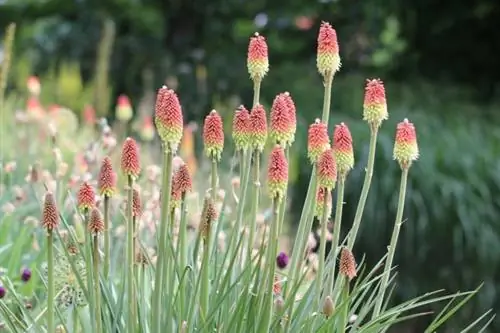
Profile
- Species/Family: Perennial. Belongs to the Asphodelaceae family
- Care effort: Low. Easy to care for and robust, only requires winter protection
- Flowering period: June to September with candle-shaped spikes on long, thick flower stalks; In some varieties the buds are orange to red and the flowers are yellow; Since the plant blooms from below, it is two-colored (orange-red buds at the top, yellow flowers at the bottom); However, most varieties bloom in pure yellow, orange or red
- Foliage: Wintergreen. Narrow, firm, grass-like, slightly arching leaves in dark green
- Growth: Upright bushy clump-like
- Height/width: Depending on the variety, 50 to 150 cm high and 40 to 60 cm wide
- Location: Sunny, warm, preferably protected from rain and wind. Nutrient-rich, well-drained, dry rather than always wet soil
- Planting time: cold germination. Anytime as long as the ground is not frozen
- Cut: Shorten by a third in spring
- Partner: Solitaire
- Propagation: Division of the rootstock in early spring or after flowering; Rootstock is very firm, so use a sharp knife
- Care: Remove spent stems; only water if there is prolonged drought; Add compost in the spring, but it is not absolutely necessary
- Wintering: Does not tolerate severe frosts without snow (bare frost) or winter wetness, so tie leaves together to protect the heart and cover the root area with compost or mulch
Special features
- Breeding, with most species coming from Africa and Madagascar
- good as a cut flower
- can also be kept in a bucket
- Flowers attract many bees and bumblebees
Species
- Crested torch lily (Kniphofia uvaria): height 80 cm; Blooms from July to September with two-tone flower candles, slightly yellow at the bottom and orange-red towards the top
- Dwarf torch lily (Kniphofia caulescens): height 100 cm; blooms from July to August in orange, yellow or red, often multicolored
- Kniphofia rooperi: rather small, broad heads in yellow, orange or red
Varieties (selection)
- `Alcazar: height 50-90 cm; Buds and flowers plain orange-red
- `Bressingham` series: height 70 cm; Buds and flowers in different shades of orange
- `Firestick Mixture: Dwarf Torch Lily; Blooms from July to August with up to 20 cm long flower candles on 1m high stems in orange-red-yellow
- `Limelight: height 80 cm; light yellow flowering variety
- `New mix: Crested Torch Lily; height 80cm; Blooms from July to September with yellow flower candles below and orange-red above
- `Royal Standard: Height 80-100 cm; Blooms from June to September in two colors with yellow flowers below and fiery red buds above
- `Sunningdale Yellow: height 50 cm; Buds and flowers are solid yellow

